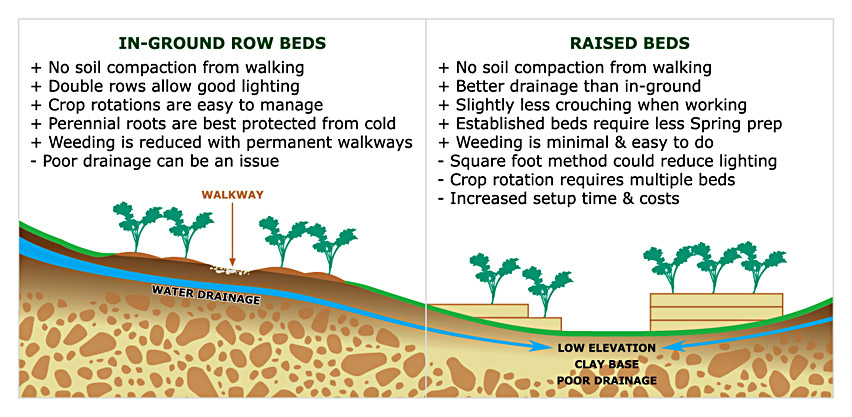How to Install Raised Bed Gardens:
Conventional farming techniques usually involve cultivating a large plot of land which is planted in rows. This method works fine if you have the land to do it. But many city or suburban dwellers simply lack the required space. Some may have the space, but they think of all that watering and weeding and rototilling... and well, their eyes just glaze over. That's why people have begun to look for new, fresh approaches.
- Switching to Raised Bed Gardens:
- What Type of Garden Bed Option Works Best?
- Benefits of Raised Beds vs Inground Beds
- How to Construct a Raised Bed Garden
- What Soil to Use For Raised Beds
- What is Square Foot Gardening?
What Type of Garden Bed Option Works Best?
OLD SCHOOL IN-GROUND BEDS: Conventional in-ground garden beds have several limitations that make them unappealing to home gardeners. A big reason for using traditional in-ground rows is that they're very practical at large scale. They allow access to heavy machinery like tractors and plows. They don't require elaborate infrastructure, just fertile land. Although many farmers have made advancements in no-plow techniques, it's easy for compaction to occur, even if it's just from walking through the planting rows. Weeds tend to be much more prevalent and require greater effort to keep them in check. Whether it's to reduce surface weeds or to simply reduce soil compaction, home gardeners may easily get locked into an annual cycle of rototilling each Spring.
HOW TO AVOID ROTOTILLING: You could avoid rototilling by making simple tweaks to the old-school in-ground method. Simply double up your planting rows. I call these in-ground row beds. The walking space between each row bed can be slightly wider than conventional rows. This space can become a permanent walkway. You could mulch it or even use stones / bricks to keep out weeds. Your paths are never cultivated & never need plowed. Your beds are never walked on and don't get compacted. As a result soil tilling may be eliminated. Watering can be done efficiently with drip irrigation. Soil amendments are not wasted on walking spaces.
SWITCHING TO RAISED BEDS: In-ground row beds cost little to set up versus conventionally spaced rows. The next step would be to consider raising those rows. You could try mounding up the dirt or building frames that are backfilled with soil / compost. Why bother with this? First: Soil Improvement. If your native soil is hard clay or is very infertile, you could add rich, amended soil right on top. Secondly: Drainage. If your plot is in a low lying or poorly drained area, raising your planting bed can help dramatically.
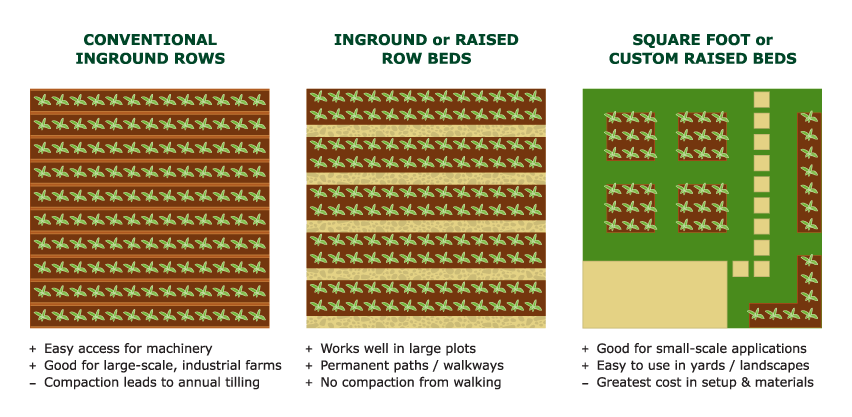
Depending upon available resources, machinery & lot size, raised garden beds offer several advantages.
Benefits of Raised Beds vs Inground Beds
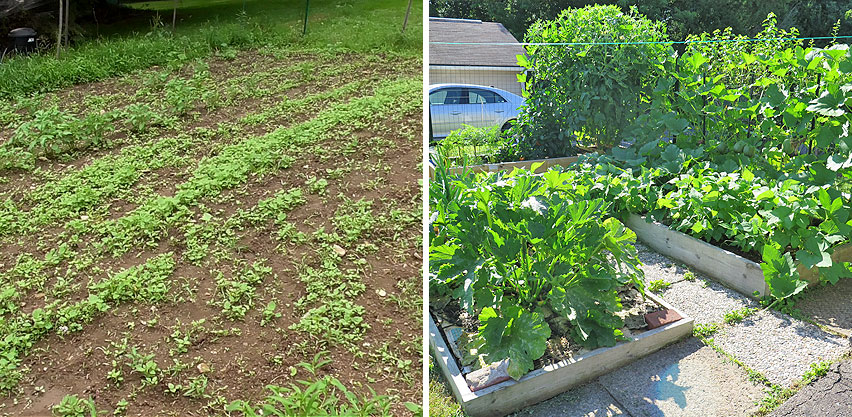
Compared to muddy in-ground garden plots, solid paths between raised beds make them much easier to work in.
EASE OF ACCESS: Raised bed gardens can be extremely easy to work in. Although the walls of the beds could be as short as 6 inches, some gardeners will raise the beds up to height of 24 inches or even more. This reduces the need to bend down when working in the soil. It's perfect for people who have physical limitations that make it hard to bend or work at ground level. The compact nature of raised bed gardens also allows you to create solid walkways between each bed. This makes them safer, reducing any risk of slipping on soggy soil and possibly falling.
IMPROVED DRAINAGE: Raised beds work exceptionally well in areas that are have poor drainage or are prone to flooding or pooling of water. Although this might mean the beds need watered a little more often during dry spells, a raised bed garden will fare much better it wet climates. And the beds are much more likely to withstand torrential downpour events without washing out.
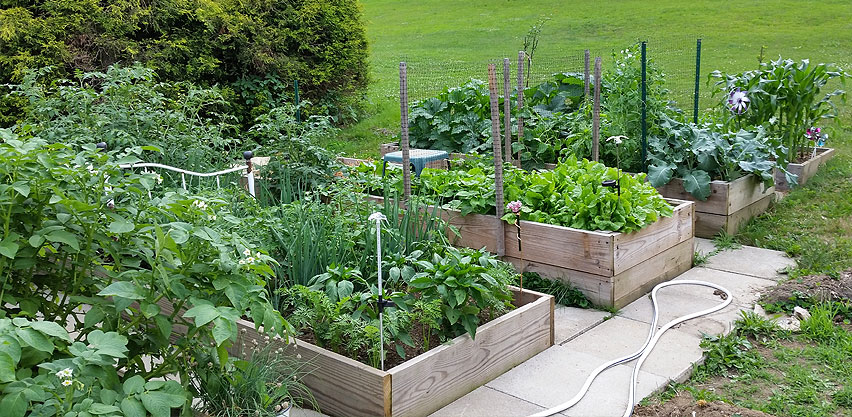
These elevated wooden raised bed planters have made it much easier for my grandparents to grow their vegetable garden.
IMPROVED SOIL QUALITY: In many urban residential lots, the native soil is extremely poor. There may only be a couple inches of topsoil which quickly gives way to a dense clay or rocky base. In fertile, impermeable soil will not yield good results. Additional, some properties might have contamination from heavy metals like lead or other toxins. But constructing a raised garden bed, you can import fresh, fertile soil. It can be placed right on top of native soil, giving your vegetables a huge boost in growth!
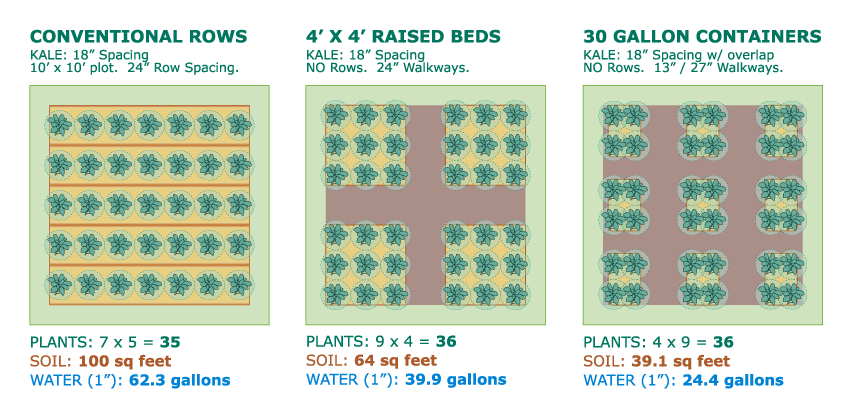
Switching from conventional row farming can lead to great soil & water savings.
REDUCED WATER CONSUMPTION: Raised beds allow gardeners to grow crops in clusters of high density. That means you could grow the exact same number of plants in significantly less space. Whether you use a sprinkler, drip irrigation or if you simply water by hand you'll need less water to achieve the same results. Rather than simply watering large swaths of soil, you'll only be watering plants' roots. You'll be replacing what the plants are actually using with much less overspray.
REDUCED THERMAL INERTIA: Because raised beds sit above the surrounding soil grade, they can thaw out faster in the Spring. This can be beneficial for gardeners who want to begin working the soil earlier in the season. Planting onion bulb starts is one reason why raised beds work better. Of course, this one can be a two-edged sword. Not only are raised beds faster to thaw in the Spring, but they are also faster to freeze in the Fall. In general, they have faster temperature swings the higher up they get from the ground. Some seeds like corn need warm temperatures for proper germination. In this regard, raised beds facilitate earlier planting dates.
How to Construct a Raised Bed Garden
Raised garden beds are easy to construct and quick to install. You can select from a broad range of construction materials. Just be aware that you'll need to have some sort of soil to fill them with.
Video: How to Build a Raised Bed Garden
See an easy way to install a raised bed garden for improved soil quality.WHAT MATERIALS TO USE FOR RAISED BEDS? There are many options for constructing a nice raised bed garden. Retailers now offer a variety of kits to choose from. These may be wooden. Many gardeners prefer cedar boards. Put plastic or composite based boards would work as well. You could also get yourself a few boards and design your own. A budget solution would be to buy 1" x 6" boards, but you could go up to 2" x 12" for more depth and stability.
THE CHEAPEST RAISED BEDS: The cheapest way to create a raised garden bed is to use reclaimed materials. By upcycling old boards, you may be able to get what you need for free. Some people will use old wooden pallets. They could be broken down and then assembled into a basic garden bed. Such materials might not last as long, but if you're on a tight budget it might be an easy way to get started.
LONGER LASTING RAISED BED MATERIALS: If wood prices are high in your area, you could consider corrugated roofing sheets. Galvanized metal will hold up for a long time and it might be cheaper than wood. Some gardeners have used stone products. You can expect these to last the longest. It could be stacked stones, "cinder" blocks (concrete ones), or fancy retaining wall blocks. Some motivated gardeners have even formed concrete molds for custom raised beds.
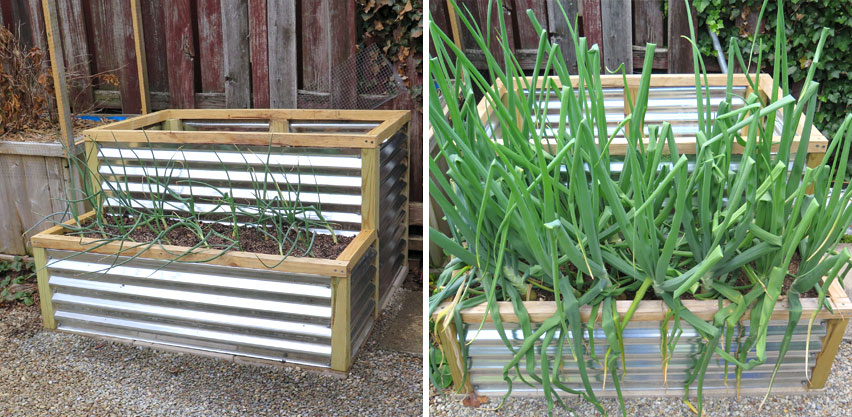
This raised bed, made from corrugated galvanized metal, doubles as a worm bin. It grew massive onions!
IS TREATED LUMBER SAFE FOR GARDEN BEDS? Some sources will warn you against using pressure treated lumber. Alarmists throw out the word "chemicals" without producing any real facts. Here are the facts: As of 2004, residential lumber sold in the US is no longer treated with chromated copper arsenate (CCA). The "chemicals" people were afraid of (arsenic and chromium) have been replaced by alkaline copper quaternary (ACQ). I have seen no evidence that ACQ lumber poses any threats when used in garden beds. So buy new treated lumber and you'll be ok. And your bed will last longer than untreated wooden beds. I recommend selecting treated boards that are specifically labeled for ground contact.
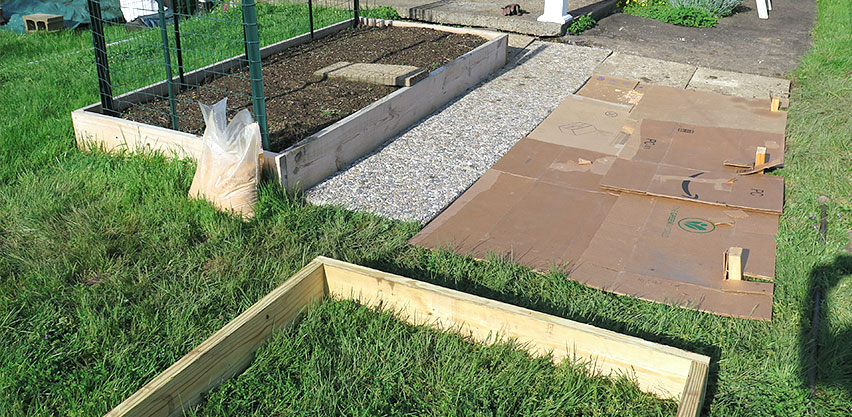
This shallow raised bed was installed directly over grass lawn with cardboard as a short term weed suppression barrier.
HOW TO INSTALL RAISED BEDS OVER GRASS LAWN: Your established grass lawn may have at least a couple inches of native top soil. By installing a raised bed directly on top of it, you can add a significant amount of rich fertile soil. Generally, there's no need to rip out the existing grass if you don't want to. However, if your bed is less than 12 inches deep, it's possible that the grass will just grow right up through the bed. Some people will first apply a layer of landscape fabric to prevent this. However, this is not necessary.
I much prefer to use a double thick layer of cardboard. Just place your box directly over the cardboard sheets and fill it with soil. This will easily kill off any weeds and grass. Over time, the cardboard will break down, allowing plant roots to reach all the way into the sub-soil. The only reason I would consider landscape fabric is if there were large trees adjacent to your beds. The fabric could be used to keep out tree roots. But I would only do this with beds that are 12 inches deep or more. Otherwise, your vegetable plant roots could be needlessly restricted by that fabric.
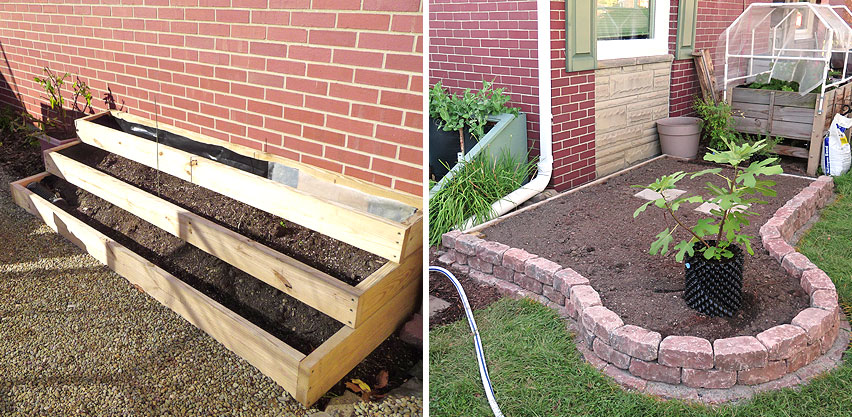
Treated lumber works well for terraced raised beds. Concrete retaining wall blocks last forever & allow for curved bed designs.
What Soil to Use For Raised Beds
PREMIUM: MEL'S MIX If you have the budget for it you might consider special soil mix known as "Mel's Mix." It's a blend that consists of: 1/3 Peat Moss, 1/3 Vermiculite & 1/3 Rich Compost. The materials are typically pre-mixed on a tarp before being added to the bed. I've used this blend in a couple raised beds with very good results. But it takes a bit of effort to mix up. It's worth it if you are working with fairly small beds. But as you scale up, it quickly becomes too cost prohibitive and labor intensive.
RETAIL GARDEN SOIL: You could simply purchase bags or "garden" or "raised bed" soil from a retail store. There are bags that are organic and others that contain synthetic fertilizers. Either of these will work. If you get them on sale, you might decide to go this route for a single bed, especially if it's not too large. Every couple of years, you might find that your raised beds have settled. Topping them off with a couple retail bags of garden soil is an easy fix.

Bulk garden soil deliveries are fast and easy. For smaller projects, Mel's Mix takes more time but works really well.
EASIEST GARDEN SOIL MIX: I've found that the easiest and cheapest way to fill up raised beds is to get a delivery of garden soil mix. This should be a 50/50 mixture of top soil and compost. In my area, mushroom compost is readily available. You can get a cubic yard delivered and dumped in you driveway. Just get a wheelbarrow and start shoveling!
USING HUGELKULTUR HACK TO REDUCE SOIL NEEDS: If you are creating large, deep raised beds, you will need lots and lots of garden soil. By using my hugelkultur hack, you can significantly reduce the soil requirements. A conventional Hügelkultur is a mounded bed formed by mounding dirt on a stack of tree limbs, branches and/or logs. It works very well with old, decaying old. As shown below, we took old, rotting wood from a dead tree and broke it into pieces. We spread it along the bottom of the raised bed before topping it off with soil. When doing so, I was careful to spread the dirt into the crevices between the wood so as to avoid air gaps.

The volume displaced by wood pieces reduced our soil needs. And the plants still grew extremely well!
WHAT ABOUT SIP BEDS? For amazing results in my wicking, aka sub-irrigated planters, I don't use top soil products. I stick with potting mix components. I have lots more info on my site about that.
READ MORE: Setting Up Your SIP Planter →
What is Square Foot Gardening?
SQUARE FOOT GARDENING DISTINCTIONS: A popular raised bed method is to build beds that are no wider than 4 feet. Commonly referred to as Square Foot Gardening, the idea is to reach from outside of the bed and NEVER actually step into it. This eliminates the need for rows, reduces weeding, watering and soil compaction. This is not any different from other raised bed garden approaches.
There are two trademark characteristics that set this method apart. First this technique calls for "Mel's Mix," the soil blend mentioned above. By using a 1:1:1 ratio of peat moss, vermiculite and rich compost, a raised bed's drainage is improved, also allowing for good water retention.
The second feature from which Square Foot Gardening gets its name, is the practice of partitioning the bed into a system of grids. And those grids may be further divided into smaller grid for designating plant spacing. So this method divides a bed into a grid made up of 12" squares. The largest plants are allotted 12" while smaller plants may get 6" or even 3" squares.
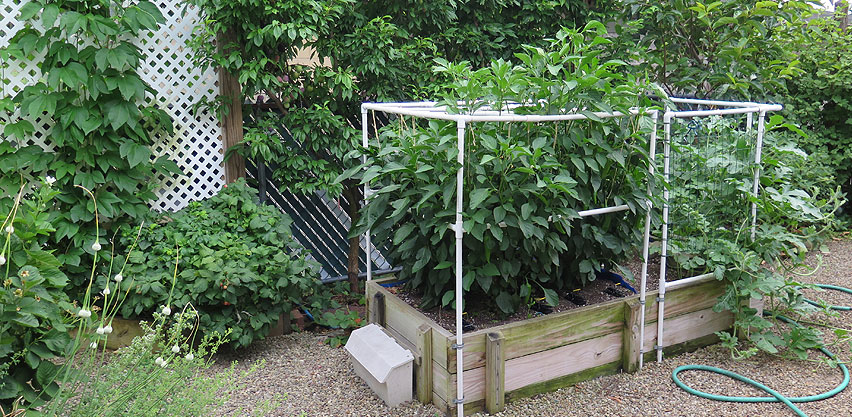
Although Square Foot Gardening has many good ideas, I've taken a different approach with my gardening & raised beds.
WHY I DON'T PRACTICE SQUARE FOOT GARDENING: Square Foot Gardening seems to yield good results. However, one thing about this method that I don't like is the spacing. But from what I've seen, some plants need more than 12" of space. Escarole, Kale, Peppers and Tomatoes may need 18" to 24" pretty easily. If your plants are crowded, some will be left starving for light. Air circulation is also reduced, which can lead to disease in extended periods of cool, damp weather. Pests, like stink bugs can be harder to identify & quickly eliminate.
For reasons like this I believe in eliminating the whole square grid system. Use the raised bed, but allow your plants to dictate the layout of your bed. Use a grid, use rows, make groupings, whatever works!
READ MORE: Pots and Containers →

